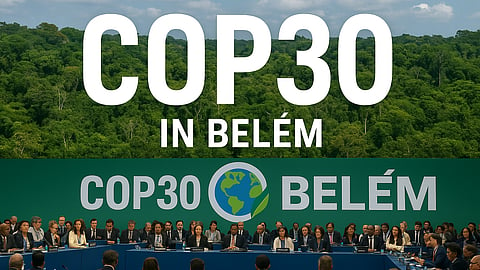COP30 in Belém: A Turning Point for Climate Action and Global Climate Politics
COP30, held in Belém, Brazil—at the heart of the Amazon—was more than a climate conference. It was a symbolic return to the world’s largest rainforest at a moment when planetary warming, biodiversity collapse, and climate inequality had reached critical levels.
With finance gaps widening and global temperatures edging dangerously close to the 1.5°C threshold, expectations for decisive outcomes were exceptionally high.
COP30 delivered a blend of breakthroughs, compromises, and unresolved tensions, but its reverberations across geopolitics, finance, and climate diplomacy are unmistakable.
A Landmark Setting: The Amazon as the Moral Anchor
Hosting COP30 in Belém gave the conference a powerful moral and political anchor. The Amazon—often described as the “lungs of the Earth”—became the living backdrop that reinforced the urgency of protecting nature-based solutions.
Brazil positioned itself as a global climate leader, advocating for forest finance, indigenous rights, and South-South cooperation. This shift rebalanced the centre of gravity in climate negotiations away from traditional power blocs like the EU and the U.S., toward emerging economies and the Global South.
Climate Finance: The Most Critical Outcome
The $1.3 Trillion Roadmap
One of the defining outcomes of COP30 was the Baku to Belém Roadmap, which reaffirmed the need for $1.3 trillion annually by 2035 to meet global climate goals. While not legally binding, this roadmap is now the central reference point for future climate finance architecture.
Key Financial Commitments and Shifts
Expansion of the Loss and Damage Fund, with developed nations expressing willingness—though not full clarity—on scaling contributions.
Increased momentum for blended finance, enabling private sector participation in mitigation and adaptation.
Recognition of the Amazon, Congo Basin, and Borneo–Mekong ecosystems as global climate assets, potentially unlocking new financing for forest nations.
Global Repercussions
These commitments address long-standing frustrations from developing nations and could unlock unprecedented flows of capital. However, the lack of binding timelines leaves implementation uncertain.
Mitigation and Adaptation: Progress with Caveats
Fossil Fuel Phaseout Language Intensifies
A significant step forward came with stronger language on fossil fuel phaseout—shifting from “phase down” to “transitioning away.” While still politically softened, the language signals a universal acceptance that fossil fuels have no long-term future.
Nature-Based Solutions Take Center Stage
With the Amazon as host, COP30 elevated forest conservation, indigenous stewardship, and biodiversity protection. The summit moved the narrative beyond carbon markets toward holistic ecological resilience.
Adaptation Wins More Attention
For the first time at a COP, adaptation finance was given equal political weight to mitigation—an overdue recognition of rising climate disasters from Asia to Africa.
Geopolitical Impact: A Reset in Global Climate Diplomacy
Rise of the Global South Bloc
Countries like Brazil, India, Indonesia, and South Africa played a more assertive role, pushing for equitable finance and technology transfer. This reconfiguration may reshape multilateral climate diplomacy for years.
U.S. and EU Influence Declines
While still major financial players, Western nations faced criticism for slow delivery of past commitments. Their bargaining power was comparatively weaker this year.
China Balances Responsibility and Leadership
China positioned itself as both a developing country advocate and a technological powerhouse, offering clean energy cooperation to forest nations while resisting pressure for binding mitigation commitments.
The Science Warning: 1.5°C Nearly Out of Reach
Scientists presented stark findings: the world is on track to exceed 1.5°C in the early 2030s. COP30’s agreements help reduce damage, but not enough to reverse the trajectory without dramatic acceleration.
The summit made clear that the window is closing fast.
Failures and Gaps: What COP30 Could Not Solve
Despite progress, several issues remained unresolved:
No binding fossil fuel phaseout timeline
Ambiguity in climate finance delivery mechanisms
Insufficient commitments from large emitters
Lack of a global deforestation end-date
These gaps risk undermining the ambition of the overall package if not addressed soon.
Conclusion: COP30 as a Pivotal, Not Perfect, Summit
COP30 was not the breakthrough moment the world may have hoped for, but it was unquestionably a turning point. By centering the Amazon, elevating the Global South, and strengthening the climate finance roadmap, Belém reshaped the global climate conversation—morally, politically, and economically.
Its legacy will depend on how governments act in the next two to three years.
The Way Forward: What Must Happen Next
Translate the finance roadmap into binding commitments
Accelerate domestic fossil fuel transition policies
Scale finance for adaptation and resilience
Protect major forests with verifiable, community-driven mechanisms
Shift from climate pledges to enforceable climate accountability
The world now moves from Belém toward implementation. COP30 has set the direction—what happens next will determine whether humanity still has a chance to stay within a livable climate future.


